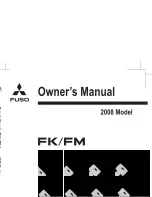
3. Push the programmed HomeLink® button to
confirm that the garage door opener motor
operates. If the garage door opener motor does not
operate, repeat the final steps for the rolling code
procedure.
Non-Rolling Code Garage Door Opener Final Steps
1. Push and hold the programmed HomeLink®
button and observe the HomeLink® indicator
light. If the HomeLink® indicator light stays on
constantly, programming is complete.
2. Push the programmed HomeLink® button to
confirm that the garage door opener motor
operates. If the garage door opener motor does not
operate, repeat the steps from the beginning.
WARNING!
●
Your motorized door or gate will open and
close while you are programming the universal
transmitter. Do not program the transmitter if
people or pets are in the path of the door or gate.
●
Do not run your vehicle in a closed garage or
confined area while programming the transmitter.
Exhaust gas from your vehicle contains carbon
monoxide which is odorless and colorless. Carbon
monoxide is poisonous when inhaled and can
cause you and others to be severely injured or
killed.
P
ROGRAMMING
H
OME
L
INK
® T
O
A
M
ISCELLANEOUS
D
EVICE
The procedure on how to program HomeLink® to a
miscellaneous device follows the same procedure as
programming to a garage door opener
Be sure to determine if the device has a rolling code,
or non-rolling code before beginning the programming
process.
NOTE:
Canadian Radio Frequency (RF) laws require transmitter
signals to time-out (or quit) after several seconds
of transmission, which may not be long enough for
HomeLink® to pick up the signal during programming.
Similar to this Canadian law, some U.S. gate operators
are designed to time-out in the same manner. The
procedure may need to be performed multiple times
to successfully pair the device to your HomeLink®
buttons.
R
EPROGRAMMING
A S
INGLE
H
OME
L
INK
®
B
UTTON
To reprogram a single HomeLink® button that has been
previously trained, without erasing all the channels,
refer to the following procedure. Be sure to determine
whether the new device you want to program the
HomeLink® button to has a rolling code, or non-rolling
code.
1. Place the ignition in the ON/RUN position, without
starting the engine.
2. Push and hold the desired HomeLink® button until
the HomeLink® indicator light begins to flash after
20 seconds. Do not release the button.
3. Without releasing the button, proceed with Step
2 in “Programming HomeLink® To A Garage Door
, and follow all remaining
steps.
C
ANADIAN
/G
ATE
O
PERATOR
P
ROGRAMMING
For programming transmitters in Canada/United States
that require the transmitter signals to “time-out” after
several seconds of transmission:
Canadian Radio Frequency (RF) laws require transmitter
signals to time-out (or quit) after several seconds
of transmission, which may not be long enough for
HomeLink® to pick up the signal during programming.
Similar to this Canadian law, some U.S. gate operators
are designed to time-out in the same manner.
It may be helpful to unplug the device during the cycling
process to prevent possible overheating of the garage
door or gate motor.
1. Place the ignition in the ON/RUN position.
NOTE:
For vehicles equipped with Keyless Enter ‘n Go™,
place the ignition in the RUN position. Make sure
while programming HomeLink® with the engine on
that your vehicle is outside of your garage, or that
the garage door remains open at all times.
2. Place the hand-held transmitter 1 to 3 inches (3 to
8 cm) away from the HomeLink® button you wish
to program while keeping the HomeLink® indicator
light in view.
3. Continue to push and hold the HomeLink® button
while you push and release (cycle) your hand-held
transmitter every two seconds until HomeLink®
has successfully accepted the frequency signal.
The indicator light will flash slowly and then rapidly
when fully trained.
4. Watch for the HomeLink® indicator to change
flash rates. When it changes, it is programmed. It
GETTING TO KNOW YOUR VEHICLE 49
2




































